Yury Malkov
Samsung AI Center
GPT-4o System Card
Oct 25, 2024Abstract:GPT-4o is an autoregressive omni model that accepts as input any combination of text, audio, image, and video, and generates any combination of text, audio, and image outputs. It's trained end-to-end across text, vision, and audio, meaning all inputs and outputs are processed by the same neural network. GPT-4o can respond to audio inputs in as little as 232 milliseconds, with an average of 320 milliseconds, which is similar to human response time in conversation. It matches GPT-4 Turbo performance on text in English and code, with significant improvement on text in non-English languages, while also being much faster and 50\% cheaper in the API. GPT-4o is especially better at vision and audio understanding compared to existing models. In line with our commitment to building AI safely and consistent with our voluntary commitments to the White House, we are sharing the GPT-4o System Card, which includes our Preparedness Framework evaluations. In this System Card, we provide a detailed look at GPT-4o's capabilities, limitations, and safety evaluations across multiple categories, focusing on speech-to-speech while also evaluating text and image capabilities, and measures we've implemented to ensure the model is safe and aligned. We also include third-party assessments on dangerous capabilities, as well as discussion of potential societal impacts of GPT-4o's text and vision capabilities.
How to Boost Face Recognition with StyleGAN?
Oct 18, 2022

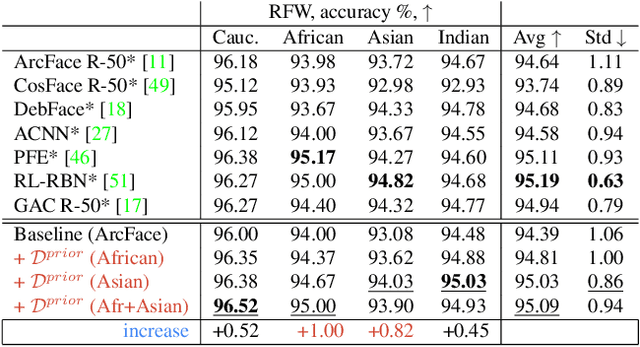

Abstract:State-of-the-art face recognition systems require huge amounts of labeled training data. Given the priority of privacy in face recognition applications, the data is limited to celebrity web crawls, which have issues such as skewed distributions of ethnicities and limited numbers of identities. On the other hand, the self-supervised revolution in the industry motivates research on adaptation of the related techniques to facial recognition. One of the most popular practical tricks is to augment the dataset by the samples drawn from the high-resolution high-fidelity models (e.g. StyleGAN-like), while preserving the identity. We show that a simple approach based on fine-tuning an encoder for StyleGAN allows to improve upon the state-of-the-art facial recognition and performs better compared to training on synthetic face identities. We also collect large-scale unlabeled datasets with controllable ethnic constitution -- AfricanFaceSet-5M (5 million images of different people) and AsianFaceSet-3M (3 million images of different people) and we show that pretraining on each of them improves recognition of the respective ethnicities (as well as also others), while combining all unlabeled datasets results in the biggest performance increase. Our self-supervised strategy is the most useful with limited amounts of labeled training data, which can be beneficial for more tailored face recognition tasks and when facing privacy concerns. Evaluation is provided based on a standard RFW dataset and a new large-scale RB-WebFace benchmark.
TwHIN-BERT: A Socially-Enriched Pre-trained Language Model for Multilingual Tweet Representations
Sep 15, 2022



Abstract:We present TwHIN-BERT, a multilingual language model trained on in-domain data from the popular social network Twitter. TwHIN-BERT differs from prior pre-trained language models as it is trained with not only text-based self-supervision, but also with a social objective based on the rich social engagements within a Twitter heterogeneous information network (TwHIN). Our model is trained on 7 billion tweets covering over 100 distinct languages providing a valuable representation to model short, noisy, user-generated text. We evaluate our model on a variety of multilingual social recommendation and semantic understanding tasks and demonstrate significant metric improvement over established pre-trained language models. We will freely open-source TwHIN-BERT and our curated hashtag prediction and social engagement benchmark datasets to the research community.
Textured Neural Avatars
May 21, 2019
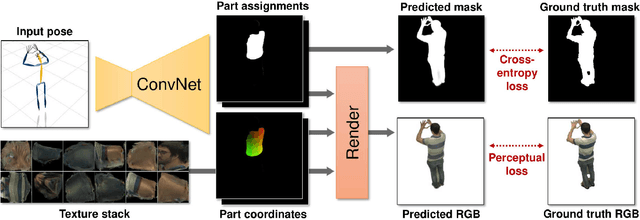
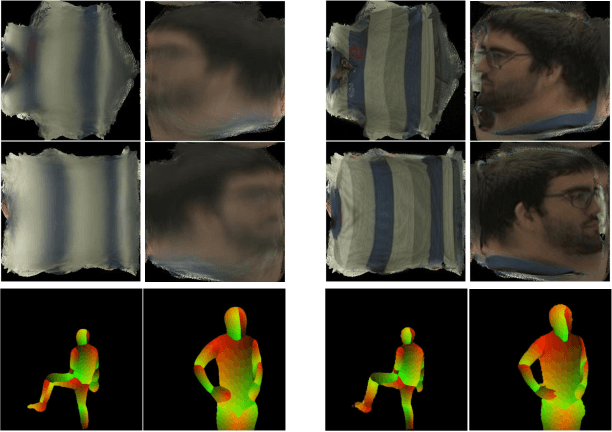

Abstract:We present a system for learning full-body neural avatars, i.e. deep networks that produce full-body renderings of a person for varying body pose and camera position. Our system takes the middle path between the classical graphics pipeline and the recent deep learning approaches that generate images of humans using image-to-image translation. In particular, our system estimates an explicit two-dimensional texture map of the model surface. At the same time, it abstains from explicit shape modeling in 3D. Instead, at test time, the system uses a fully-convolutional network to directly map the configuration of body feature points w.r.t. the camera to the 2D texture coordinates of individual pixels in the image frame. We show that such a system is capable of learning to generate realistic renderings while being trained on videos annotated with 3D poses and foreground masks. We also demonstrate that maintaining an explicit texture representation helps our system to achieve better generalization compared to systems that use direct image-to-image translation.
Learnable Triangulation of Human Pose
May 14, 2019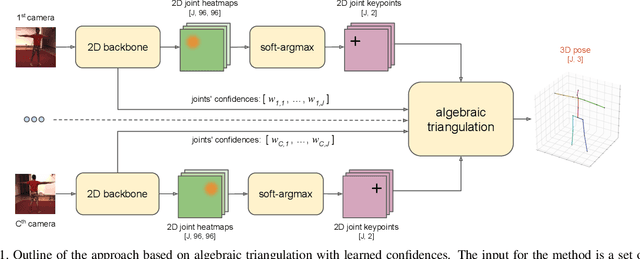
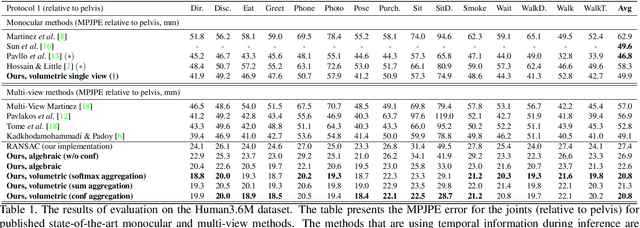
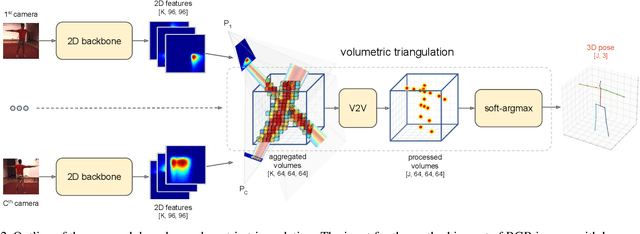

Abstract:We present two novel solutions for multi-view 3D human pose estimation based on new learnable triangulation methods that combine 3D information from multiple 2D views. The first (baseline) solution is a basic differentiable algebraic triangulation with an addition of confidence weights estimated from the input images. The second solution is based on a novel method of volumetric aggregation from intermediate 2D backbone feature maps. The aggregated volume is then refined via 3D convolutions that produce final 3D joint heatmaps and allow modelling a human pose prior. Crucially, both approaches are end-to-end differentiable, which allows us to directly optimize the target metric. We demonstrate transferability of the solutions across datasets and considerably improve the multi-view state of the art on the Human3.6M dataset. Video demonstration, annotations and additional materials will be posted on our project page (https://saic-violet.github.io/learnable-triangulation).
Revisiting the Inverted Indices for Billion-Scale Approximate Nearest Neighbors
Jul 23, 2018



Abstract:This work addresses the problem of billion-scale nearest neighbor search. The state-of-the-art retrieval systems for billion-scale databases are currently based on the inverted multi-index, the recently proposed generalization of the inverted index structure. The multi-index provides a very fine-grained partition of the feature space that allows extracting concise and accurate short-lists of candidates for the search queries. In this paper, we argue that the potential of the simple inverted index was not fully exploited in previous works and advocate its usage both for the highly-entangled deep descriptors and relatively disentangled SIFT descriptors. We introduce a new retrieval system that is based on the inverted index and outperforms the multi-index by a large margin for the same memory consumption and construction complexity. For example, our system achieves the state-of-the-art recall rates several times faster on the dataset of one billion deep descriptors compared to the efficient implementation of the inverted multi-index from the FAISS library.
 Add to Chrome
Add to Chrome Add to Firefox
Add to Firefox Add to Edge
Add to Edge